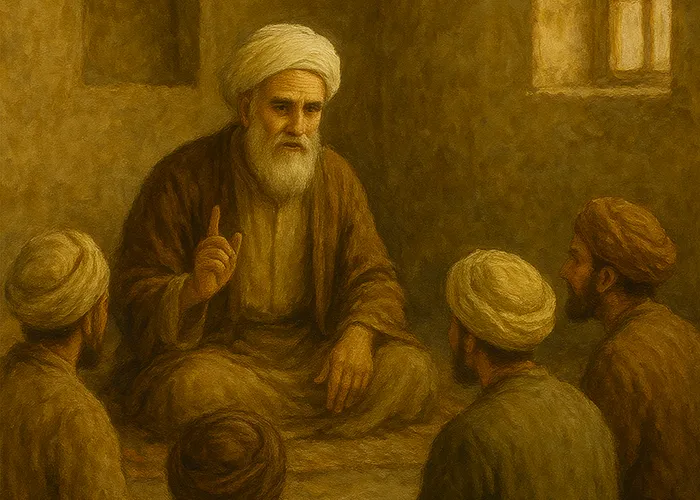Topic of the Week – Volume02 Issue31
A Step into the Depths of History: Welcoming the Pilgrims of Imam Hussain (AS)
Seyed Hashem Moosavi
Introduction
As the majestic days of Arba’een approach, millions of devoted lovers set foot on the path of love, journeying toward the holy land of Karbala to depict the pilgrimage of Arba’een in its most epic form. This grand spiritual movement is rooted in an ancient tradition that has been preserved through the perseverance of the Ahl al-Bayt (AS) and their loyal followers. Today, it is not merely a religious ritual, but a historical manifestation of loyalty and nation-building centered around devotion to the Wilayah (divine guardianship), as well as a symbol of resilience, unity, and boundless love for the Master of Martyrs, Imam Hussain (AS).
Among the manifestations of this great movement, the public service centers (Mawakib) and hospitality tents for pilgrims display scenes of selflessness, service, and unconditional love-all deeply rooted in the teachings of the Ahl al-Bayt (AS).
In this article, we will briefly explore the historical background of this ancient tradition and highlight one of the earliest and most profound examples of welcoming pilgrims: the establishment of the first hospitality tent for the pilgrims of Imam Hussain (AS) by Imam Ja’far al-Sadiq (AS).
This historical narrative not only testifies to the significance of visiting Imam Hussain (AS) but also serves as a guiding light for today’s servants on this blessed path-those who set up Mawakib and offer sincere service to the pilgrims of Hussain (AS). It also reveals a glimpse of the immense divine rewards awaiting those who engage in such service.
A Tent for Welcoming the Pilgrim of Hussain (AS)
At the beginning of Al-Mansur al-Dawaniqi’s reign, during one of the most critical periods in Shia history, Imam Ja’far al-Sadiq (AS) arrived in Najaf al-Ashraf. There, he set up a tent and assigned a special mission to one of his companions, Musa ibn Qasim al-Hadhrami.
Musa ibn Qasim narrates this mission as follows:
The Imam (AS) said to me, “O Musa! Go to the main road, stand there, and watch. Soon, a man will approach you from the direction of Qadisiyyah. When he comes near, tell him: ‘A man from the lineage of the Prophet of God (PBUH) calls for you.’ He will come with you.”
Musa says: “I went to the road and stood there. The weather was extremely hot. I remained standing until I was nearly exhausted and about to turn back. Then, I saw something approaching from afar-a man riding a camel. I watched him until he came close. I said to him: ‘O man! Here, a descendant of the Prophet of God (PBUH) invites you, and he has described certain signs about you.’ The man replied: ‘Take me to him.’ So, I brought him, made his camel kneel near the tent, and the Imam called for him. The Arab man entered the tent. I stayed nearby, listening to their conversation without seeing them.”
The Conversation Inside the Tent:
Imam al-Sadiq (AS) asked him: “Where have you come from?” The man replied: “From the farthest part of Yemen.”
The Imam (AS) said: “Are you from such-and-such region?” He answered: “Yes, I am from there.”
The Imam (AS) asked: “Why have you come here?” He said: “I have come to visit the Holy Grave of Imam Hussain (AS).”
The Imam (AS) asked: “Do you have any motive other than visitation?” He replied: “No, I have no other motive. I only came to pray near him, perform his Ziyarat (pilgrimage), offer my greetings, and then return to my family.”
The Imam (AS) asked: “What is your belief regarding the Ziyara of Imam Hussain (AS)?”
The man answered: “We see blessings in his visitation-in ourselves, our families, our children, our wealth, our lives, and in the fulfilment of our needs.”
The Imam (AS) said: “O brother from Yemen! Would you like me to tell you something greater about the virtue of visiting him?” The man replied: “Please do, O son of the Messenger of God!”
The Imam (AS) declared: «إنَّ زيارة الحُسين (عليه السلام) تَعْدِل حـجّةً مقبولةً زاكيةً مع رسول اللّه» “Indeed, visiting Hussain (AS) equals one accepted and pure Hajj performed with the Messenger of God (PBUH).”
The man was astonished! The Imam (AS) affirmed: “Yes, by Allah! Rather, two accepted and pure Hajj pilgrimages with the Messenger of God (PBUH).”
Again, the man was amazed! And the Imam (AS) continued increasing the merit until he finally said: ثلاثين حـجّة مبرورةً متقبلةً زاكيةً مع رسول اللّه (صلىٰ اللّه عليه وآله) »؛ “Rather, it equals thirty accepted, pure, and blessed Hajj pilgrimages performed with the Messenger of God (PBUH)!”[1]
Key Insights from the Narration of Imam Sadiq (AS) and the Yemeni Pilgrim
- The Ancient Tradition of Visiting Imam Hussain (AS)
This narration clearly demonstrates that even during the oppressive early Abbasid era under Al-Mansur, visiting Imam Hussain’s (AS) shrine was an established and revered practice among Shia Muslims. The fact that a man travelled from “the farthest reaches of Yemen” specifically for Ziyara testifies to its widespread recognition and significance among believers of that time.
- The Incomparable Virtue of Visiting Imam Hussain (AS)
Imam Sadiq (AS) equates visiting Imam Hussain (AS) with thirty accepted Hajj pilgrimages performed alongside the Prophet (PBUH). This extraordinary comparison reveals the supreme spiritual status of this sacred visitation.
- The Elevated Status of Imam Hussain’s (AS) Pilgrims
The Imam’s (AS) exceptional care for this pilgrim is evident from the outset:
- Personally, preparing for the visitor’s arrival
- Setting up a dedicated tent
- Providing precise descriptions to Musa ibn Qasim
This warm reception demonstrates how highly Ahl al-Bayt (AS) valued Imam Hussain’s (AS) visitors, establishing the importance of honouring and serving them.
This tradition later evolved into today’s elaborate Mowkeb system during Arba’een, making modern service stations spiritual descendants of Imam Sadiq’s (AS) original tent.
- Honouring Pilgrims as Core Shia Tradition
The Imam (AS) didn’t merely respect the pilgrim but:
- Organized preparations for his arrival
- Sent a special envoy
- Held a detailed, affectionate dialogue
This institutionalizes pilgrim hospitality as both an ethical obligation and religious practice within Shia culture.
- The Spiritual and Intellectual Dimensions of Ziyarat
The Imam’s (AS) probing questions about the pilgrim’s pure intentions (devoid of worldly motives) highlight:
- The necessity of sincerity in visitation
- The luminous spiritual journey’s proper orientation
- The transformation that occurs through genuine pilgrimage
- The Patience and Dedication Required to Serve Pilgrims
Musa ibn Qasim’s conduct is particularly instructive:
- Persisting under scorching heat
- Never abandoning his mission despite hardship
This establishes that serving Hussain’s (AS) visitors demands:
- Exceptional patience
- Unwavering commitment
- Willingness to endure difficulty
The path of service is arduous, but its rewards are infinite.
[1] . Kamil Al Ziyaraat, Ibn Qawlaway, P 305. Thawab Al ‘Amaal, Shaikh Sadooq, P 93.
editor's pick
news via inbox
Subscribe to the newsletter.




